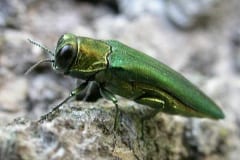Anyone with a smartphone can help control invasive species in Massachusetts at the touch of a finger. Learn how by joining the Outsmart Invasive Species Project, a collaborative project among individuals from UMass, MA Department of Conservation and Recreation, U.S. Fish and Wildlife Service, and Nature Conservancy. The Project focuses on using smartphone technology to stop the spread of non-native plants and insects that jeopardize a healthy environment.
Invasive species pose serious environmental and economic threats to communities throughout MA. In Worcester in 2008, an outbreak of Asian longhorned beetle resulted in the destruction of nearly 30,000 trees, a loss that will take decades for the community to recoup. Last summer, the first adult emerald ash borer was found in Dalton, MA, and Berkshire County is currently defined as a quarantine area.
Early detection and continual monitoring are key to stopping new invasive insect threats like the Asian longhorned beetle and emerald ash borer, whether in a forest or an urban neighborhood, and the same is true for invasive plant species. And the good news is that anyone with a smartphone is equipped to help.
How You Can Get Involved
The Outsmart team, partnering with the Nature Conservancy’s Don’t Move Firewood program, will visit music festivals, farmers’ markets, and other events throughout the summer to conduct in-person training in invasive species identification and on use of the Outsmart app. The Outsmart Invasive Species smartphone application helps users report invasive plant and insect species quickly and easily.
Join the Outsmart Invasive Species Project and help scientists cover more ground by looking for invasive species anytime – while walking the dog, hiking, fishing, gardening, or working outdoors. It’s easy. If you have an iPhone or Android, download the FREE Outsmart Invasive Species application through iTunes or Google Play, and you’ll be prepared to identify and report invasive species anytime. If you downloaded the application in 2012, we encourage you to update the application to take advantage of new functionality and identification training videos.
Stay up to date by visiting the Outsmart Invasive Species Facebook page, by following Outsmart on Twitter @outsmartapp, or by signing up for regular updates through the Outsmart e-mail listserv. For more information, go to www.masswoods.net/outsmart.
You can also email the project team directly for more information: outsmartinvasivespecies@gmail.com.
About the Author
Julia Sullivan is an intern with The Nature Conservancy’s Forest Health program and studies Environmental Studies at American University in Washington, D.C. She may be reached at julia.sullivan@american.edu.




